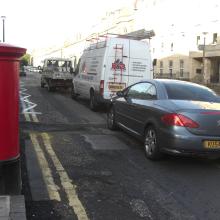
In Breaking news yesterday, we republished the Council's radar-generated statistics for traffic volumes and speeds along parts of the York Place diversion route.
Reader Neil Jones responded on Facebook with the comment: 'The central problem here is the Council's love of quoting average speeds, which are meaningless in this context. Unless they are going to give figures for the percentage of vehicles exceeding the speed limit and maximum speeds, there is very little point in discussing the issue.'
Spurtle's David Sterratt is similarly sceptical, and got to work on the figures. In the spreadsheet below, he has adapted the Council account of Albany Street from 27 September to 2 October by adding a further three columns (S, T and U) from which a different interpretation of vehicle speeds can be extrapolated.
What emerges is that although the average mean speed was just over 20.1mph between 7am and 7pm on Thursday 27th September, 42 per cent of vehicles were going faster than 20mph. Suddenly, the numbers don't look so comforting.
Even when traffic was slower, during the morning and evening peaks, about 35 per cent of vehicles were going faster than 20mph.
On a brighter note, at least the proportion of vehicles breaking the 30mph speed limit was low during the daytime – around 1 per cent.
Sterratt also notes research published by the Royal Society for the Prevention of Accidents (see pdf below) suggesting 20mph signs are ineffective, unlike engineering solutions such as humps and chicanes.
Such permanent engineering solutions are expensive, but temporary ones – like those recently employed on McDonald Road – need not be. Will the Council consider introducing them on the York Place diversion route as an alternative to the administratively cumbersome mechanism of RTOs for enforcing speed limits?
----------------------------
Reactions on Facebook and Twitter
 Neil Jones The central problem here is the council's love of quoting average speeds, which are meaningless in this context. Unless they are going to give figures for the percentage of vehicles exceeding the speed limit and maximum speeds, there is very little point in discussing the issue.
Neil Jones The central problem here is the council's love of quoting average speeds, which are meaningless in this context. Unless they are going to give figures for the percentage of vehicles exceeding the speed limit and maximum speeds, there is very little point in discussing the issue.
Fergus Smith The article asks "Will the Council consider introducing them on the York Place diversion route as an alternative to the administratively cumbersome mechanism of RTOs for enforcing speed limits?" I would have thought that, given we're talking about Edinburgh Council here, the answer would obviously be no. Quite apart from the severe implausibility of Edinburgh Council making a sensible decision - something that it appears utterly incapable of doing - such a move would also entail the council acknowledging, at least tacitly, that its previous decision was somewhat less than optimal, something that in my experience CEC has rarely if ever done.